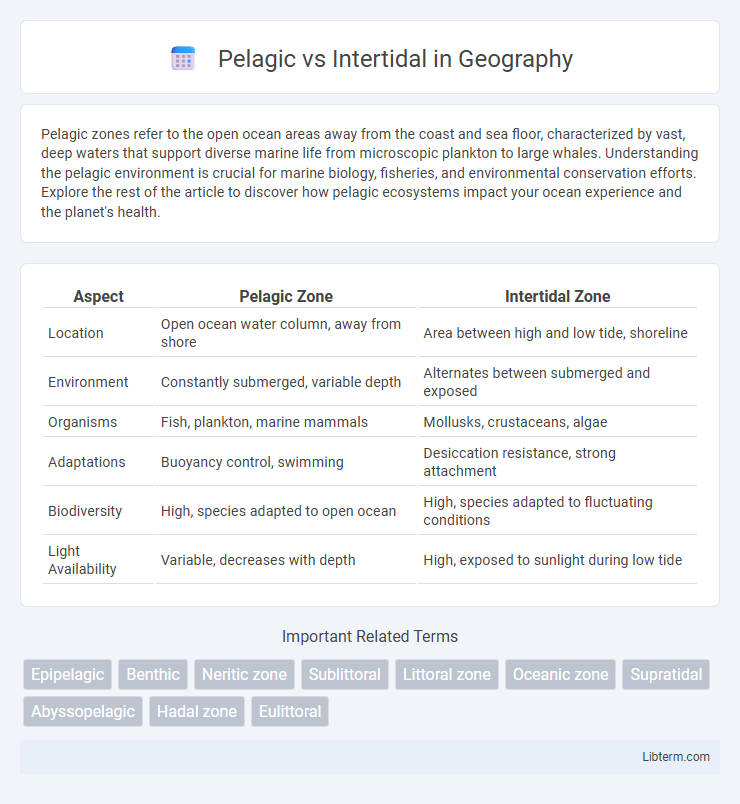Pelagic zones refer to the open ocean areas away from the coast and sea floor, characterized by vast, deep waters that support diverse marine life from microscopic plankton to large whales. Understanding the pelagic environment is crucial for marine biology, fisheries, and environmental conservation efforts. Explore the rest of the article to discover how pelagic ecosystems impact your ocean experience and the planet's health.
Table of Comparison
| Aspect | Pelagic Zone | Intertidal Zone |
|---|---|---|
| Location | Open ocean water column, away from shore | Area between high and low tide, shoreline |
| Environment | Constantly submerged, variable depth | Alternates between submerged and exposed |
| Organisms | Fish, plankton, marine mammals | Mollusks, crustaceans, algae |
| Adaptations | Buoyancy control, swimming | Desiccation resistance, strong attachment |
| Biodiversity | High, species adapted to open ocean | High, species adapted to fluctuating conditions |
| Light Availability | Variable, decreases with depth | High, exposed to sunlight during low tide |
Introduction to Pelagic and Intertidal Zones
Pelagic zones encompass the open ocean waters away from the coast and sea floor, characterized by vast, nutrient-diverse habitats supporting plankton, fish, and marine mammals. Intertidal zones lie between high and low tide marks, hosting organisms adapted to fluctuating moisture, temperature, and salinity conditions. Both zones play critical roles in marine biodiversity and ecosystem services, influencing oceanic food webs and coastal protection.
Defining Pelagic and Intertidal Ecosystems
Pelagic ecosystems encompass the open ocean waters away from the coast, characterized by free-floating organisms such as plankton, fish, and marine mammals adapted to vast, deep, and dynamic water columns. Intertidal ecosystems exist in the coastal zone between high and low tide marks, where organisms endure fluctuating conditions including exposure to air, varying salinity, and wave action. These ecosystems differ primarily in their physical environment, biodiversity, and the adaptive strategies of resident species.
Key Environmental Differences
Pelagic environments refer to the open ocean waters away from the shore, characterized by vast water columns, stable temperature, and limited nutrients, supporting diverse planktonic and pelagic species. Intertidal zones exist at the coastal interface between high and low tides, experiencing fluctuating conditions such as variable salinity, temperature extremes, and periodic exposure to air, which create a unique habitat for specially adapted organisms like barnacles and sea stars. The key environmental differences hinge on water stability, nutrient availability, and exposure to atmospheric conditions, influencing the biodiversity and ecological dynamics in each zone.
Common Flora and Fauna
Pelagic zones host diverse flora such as phytoplankton and zooplankton, with fauna including large pelagic fish like tuna, dolphins, and various species of whales. Intertidal zones feature hardy flora such as seaweeds (kelp, rockweed) and salt-tolerant grasses, alongside fauna like barnacles, mussels, crabs, sea stars, and anemones adapted to fluctuating tides. These ecosystems differ markedly in species adapted to open ocean versus tidal exposure.
Adaptations to Pelagic Conditions
Pelagic organisms exhibit adaptations such as streamlined bodies for efficient swimming, buoyancy control mechanisms like swim bladders or lipid storage, and enhanced sensory systems to detect prey and predators in open water. These adaptations permit survival in the dynamic, light-variable, and nutrient-dispersed pelagic zone, contrasting with the robust, attachment-based features of intertidal species exposed to fluctuating tides and substrate. Metabolic and reproductive strategies in pelagic species are also specialized to maximize dispersal and resource utilization across vast oceanic expanses.
Adaptations to Intertidal Conditions
Organisms in intertidal zones exhibit specialized adaptations such as strong attachment structures like holdfasts or suction cups to withstand wave action and avoid dislodgement. They have developed tolerance to extreme fluctuations in temperature, salinity, and moisture during tidal changes, often through mechanisms like desiccation resistance and osmotic regulation. Behavioral adaptations include retreating into crevices or shells to minimize exposure during low tide, ensuring survival in this highly variable and dynamic environment.
Ecological Roles and Interactions
Pelagic ecosystems, located in the open ocean, support vast biodiversity through primary production by phytoplankton and serve as critical feeding and breeding grounds for migratory species like whales and tuna. Intertidal zones, found along coastlines, exhibit dynamic ecological interactions driven by tidal fluctuations, hosting diverse organisms such as barnacles, mussels, and sea stars that contribute to nutrient cycling and habitat structuring. These zones play essential roles in linking marine and terrestrial ecosystems by facilitating nutrient transfer, providing nursery habitats, and supporting complex predator-prey relationships unique to their fluctuating environments.
Human Impacts on Pelagic and Intertidal Areas
Human impacts on pelagic zones include overfishing, pollution from plastic waste, and climate change-driven ocean acidification, which disrupt marine food webs and biodiversity. Intertidal areas face habitat destruction from coastal development, trampling by tourism, and pollution, leading to reduced species diversity and altered ecosystem functions. Both zones suffer from anthropogenic pressures that threaten their ecological balance and resilience.
Conservation Challenges and Strategies
Conservation challenges in pelagic zones include habitat degradation due to overfishing and pollution affecting migratory marine species, while intertidal zones face threats from coastal development and climate-induced sea level rise impacting biodiversity hotspots. Effective strategies in pelagic conservation emphasize sustainable fishing practices, marine protected areas, and international cooperation to manage wide-ranging species. Intertidal conservation prioritizes habitat restoration, pollution control, and public education to preserve the delicate balance of these dynamic coastal ecosystems.
Summary: Comparing Pelagic and Intertidal Zones
Pelagic zones, covering the open ocean waters away from the shore, host diverse marine life adapted to varying depths and light conditions. Intertidal zones, situated between high and low tide marks, experience fluctuating environments with organisms adapted to withstand exposure to air and changing salinity. The key difference lies in habitat stability, with pelagic zones providing a more constant aquatic environment compared to the highly dynamic and stressful conditions of intertidal zones.
Pelagic Infographic

 libterm.com
libterm.com